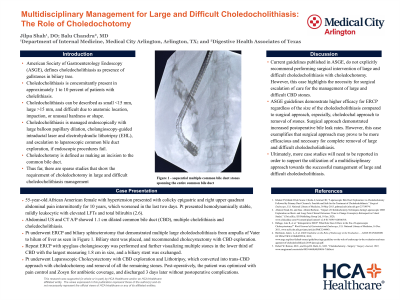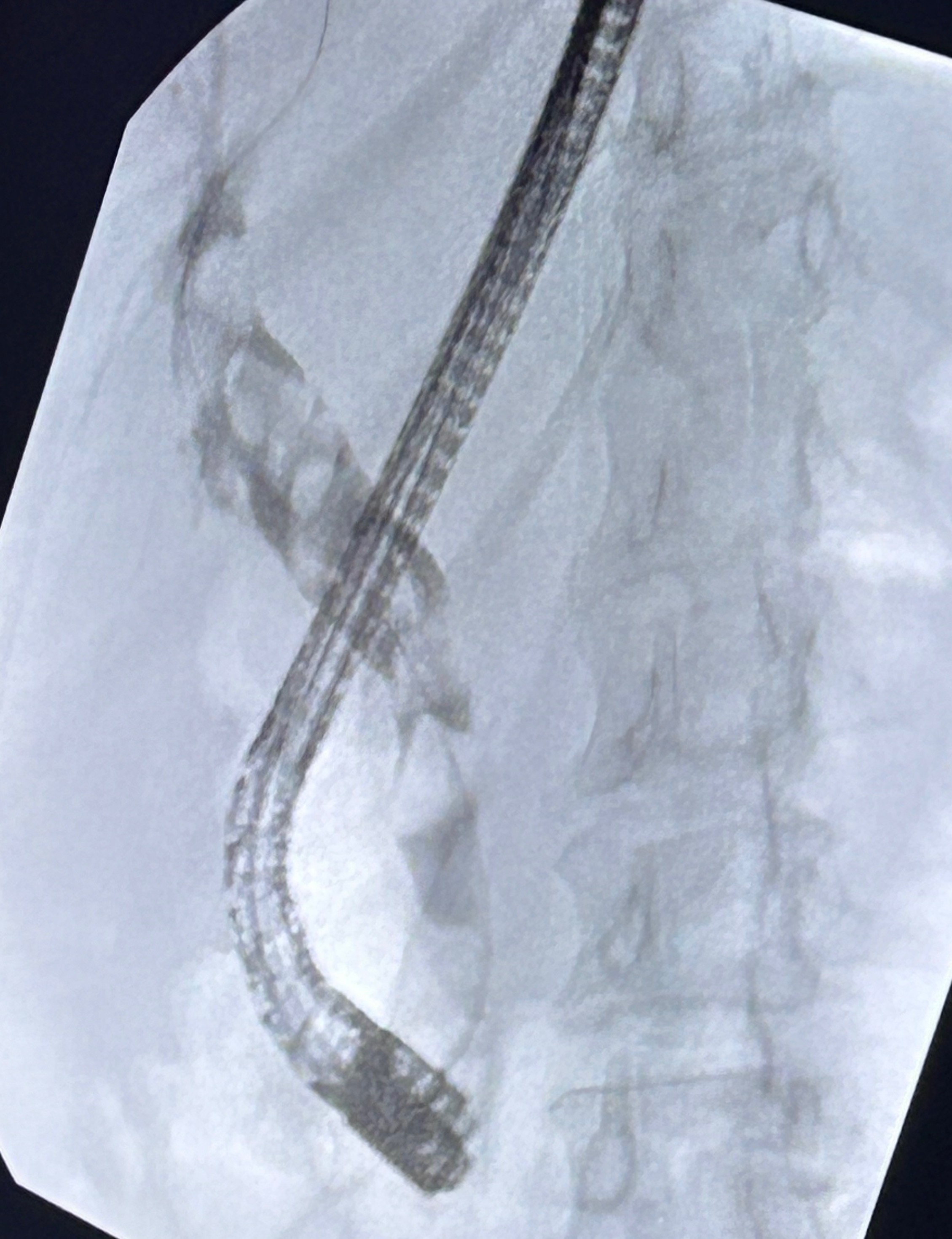Tuesday Poster Session
Category: Interventional Endoscopy
P4535 - Multidisciplinary Management for Large and Difficult Choledocholithiasis: The Role of Choledochotomy
Tuesday, October 29, 2024
10:30 AM - 4:00 PM ET
Location: Exhibit Hall E

Has Audio

Jilpa Shah, DO
Medical City Healthcare
Arlington, TX
Presenting Author(s)
Jilpa Shah, DO, Balu Chandra, MD
Medical City Healthcare, Arlington, TX
Introduction: According to the American Society of Gastroenterology Endoscopy (ASGE), choledocholithiasis is defined as presence of gallstones in biliary tree.
Choledocholithiasis is concomitantly present in approximately 1 to 10 percent of patients with cholelithiasis. Choledocholithiasis can be described as small < 15 mm, large >15 mm, and difficult due to anatomic location, impaction, or unusual hardness or shape. Choledocholithiasis is managed endoscopically with large balloon papillary dilation, cholangioscopy-guided intraductal laser and electrohydraulic lithotripsy (EHL), and escalation to laparoscopic common bile duct exploration, if endoscopic procedures fail. Thus far, there are sparse studies that show the requirement of choledochotomy in large and difficult choledocholithiasis management.
Case Description/Methods: 55-year-old black female with hypertension presented with colicky epigastric and right upper quadrant abdominal pain intermittently for 10 years, which was self-resolving. She presented hemodynamically stable, mildly leukocytic with elevated LFTs and dilated common bile duct (CBD) on Abdominal US and CTA suggested multiple cholelithiasis and choledocholithiasis. She underwent ERCP and biliary sphincterotomy that demonstrated multiple large choledocholithiasis from ampulla of Vater to hilum of liver as seen in Figure 1, biliary stent was placed, and recommended cholecystectomy with CBD exploration. Repeat ERCP with spyglass cholangioscopy was performed and further visualizing multiple stones in the lower third of CBD with the largest measuring 1.8 cm in size. She required surgery by a Hepatobiliary surgeon and underwent Laparoscopic Cholecystectomy with CBD exploration and Lithotripsy, which converted into choledochotomy and removal of all the remaining stones. Irregular green to tan-brown stones. Post-operatively, the patient was optimized with pain control and Zosyn for antibiotic coverage, and discharged 3 days later without postoperative complications.
Discussion: Current guidelines published in ASGE, do not explicitly recommend performing surgical intervention of large and choledocholithiasis with choledochotomy. However, this case highlights the necessity for surgical escalation of care for the management of large and difficult CBD stones. Ultimately, more case studies will need to be reported in order to support the utilization of a multidisciplinary approach towards the successful management of large and difficult choledocholithiasis.

Disclosures:
Jilpa Shah, DO, Balu Chandra, MD. P4535 - Multidisciplinary Management for Large and Difficult Choledocholithiasis: The Role of Choledochotomy, ACG 2024 Annual Scientific Meeting Abstracts. Philadelphia, PA: American College of Gastroenterology.
Medical City Healthcare, Arlington, TX
Introduction: According to the American Society of Gastroenterology Endoscopy (ASGE), choledocholithiasis is defined as presence of gallstones in biliary tree.
Choledocholithiasis is concomitantly present in approximately 1 to 10 percent of patients with cholelithiasis. Choledocholithiasis can be described as small < 15 mm, large >15 mm, and difficult due to anatomic location, impaction, or unusual hardness or shape. Choledocholithiasis is managed endoscopically with large balloon papillary dilation, cholangioscopy-guided intraductal laser and electrohydraulic lithotripsy (EHL), and escalation to laparoscopic common bile duct exploration, if endoscopic procedures fail. Thus far, there are sparse studies that show the requirement of choledochotomy in large and difficult choledocholithiasis management.
Case Description/Methods: 55-year-old black female with hypertension presented with colicky epigastric and right upper quadrant abdominal pain intermittently for 10 years, which was self-resolving. She presented hemodynamically stable, mildly leukocytic with elevated LFTs and dilated common bile duct (CBD) on Abdominal US and CTA suggested multiple cholelithiasis and choledocholithiasis. She underwent ERCP and biliary sphincterotomy that demonstrated multiple large choledocholithiasis from ampulla of Vater to hilum of liver as seen in Figure 1, biliary stent was placed, and recommended cholecystectomy with CBD exploration. Repeat ERCP with spyglass cholangioscopy was performed and further visualizing multiple stones in the lower third of CBD with the largest measuring 1.8 cm in size. She required surgery by a Hepatobiliary surgeon and underwent Laparoscopic Cholecystectomy with CBD exploration and Lithotripsy, which converted into choledochotomy and removal of all the remaining stones. Irregular green to tan-brown stones. Post-operatively, the patient was optimized with pain control and Zosyn for antibiotic coverage, and discharged 3 days later without postoperative complications.
Discussion: Current guidelines published in ASGE, do not explicitly recommend performing surgical intervention of large and choledocholithiasis with choledochotomy. However, this case highlights the necessity for surgical escalation of care for the management of large and difficult CBD stones. Ultimately, more case studies will need to be reported in order to support the utilization of a multidisciplinary approach towards the successful management of large and difficult choledocholithiasis.

Figure: Figure 1 - sequential multiple common bile duct stones spanning the entire duct
Disclosures:
Jilpa Shah indicated no relevant financial relationships.
Balu Chandra indicated no relevant financial relationships.
Jilpa Shah, DO, Balu Chandra, MD. P4535 - Multidisciplinary Management for Large and Difficult Choledocholithiasis: The Role of Choledochotomy, ACG 2024 Annual Scientific Meeting Abstracts. Philadelphia, PA: American College of Gastroenterology.
